2D + 2D = 3D pt.3
 Wednesday, February 25, 2009 at 10:57AM
Wednesday, February 25, 2009 at 10:57AM In part 1 of this series I covered some common conventions and design features of 2D side-scrolling and 2D top down games. As the title of this series suggests, understanding 3D game design is a matter of understanding 2D game design. In part 2, I gave many examples of 2D side scrolling/top down games in addition to a few special cases. Now it's time to look at 3D games.
There is obviously a difference between 3D graphics and 3D gameplay.


Wii Fit Jogging is an example of a 1D game with 3D graphics while Track and Field is an example of a 1D game with 2D graphics.


Street Fighter HD Remix is an example of a 2D side-scrolling game with 2D graphics while Super Smash Brothers Brawl is an example of a 2D side-scrolling game with 3D graphics.


The legend of Zelda 4 Swords is a 2D top down game with 2D graphics while StarCraft 2 is a top down game with 3D graphics.
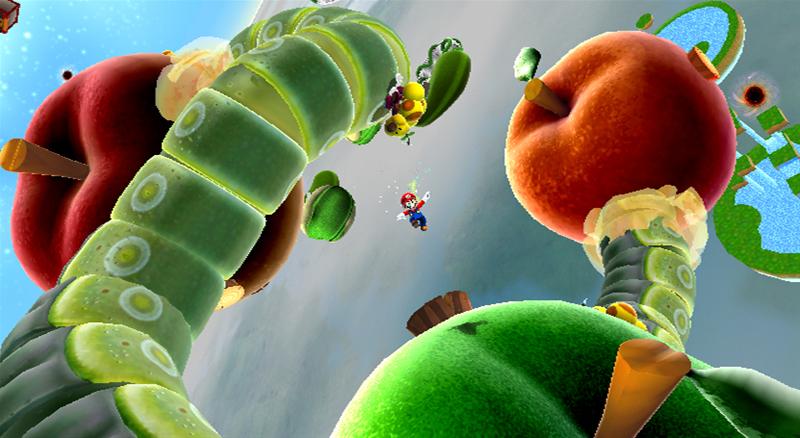
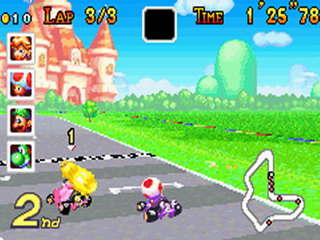
Super Mario Galaxy is a 3D game with 3D graphics, and Mario Kart Super Circuit is a 3D game with 2D graphics.
Because 1D, 2D, and 3D games can be made with 2D or 3D graphics, the graphical presentation of a game does not tell anything about the kind of gameplay a game supports. Regardless of how a game looks, understanding how a game creates 3D gameplay and whether or not the 3rd dimension is significantly used requires a close look at the specific mechanics and design of a game. First we must consider...
The Dynamics of 3D Space and Perspective
Objects in a 3D game are representational as opposed to presentational like in side-scrolling/top down games. 2D graphical games typically take 2D sprite images and code the images to create a game object. This object typically retains its proportions and visual form throughout the game. For example, all the Goomba in Super Mario Brothers act the same and look nearly identical.
But in a 3D game perspective creates new dynamic. How you view a 3D object changes the way it appears. Now you can view a simple box from the top (like in a top down game), the side (like in a side-scroller), from any angle, and from almost any distance. Instead of the artists creating a 2D image of a box that must clearly communicate to the player that it's a box, the 3D graphic designers create a model of a box so that the player can view it in as many different ways as possible.
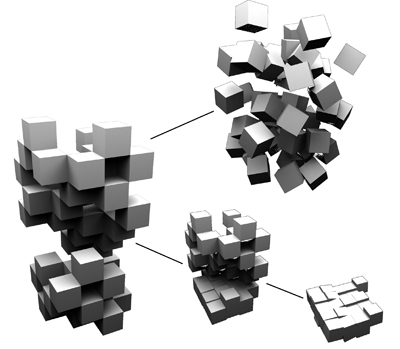
The same small box from many different angles.
Instead of using relatively simple visuals like with a 2D side-scroller or top down game where the Z and Y axes respectively exist in a significant level of interpretation, 3D games uses a far more organic kind of interpretation. Essentially, when viewing anything in 3D space, you're looking at a 3 dimensional object through a 2D lens or viewpoint. Your perspective gives you a unique viewpoint that reveals and obscures parts of that object. What you can't see, you interpret. As you move your viewpoint, your interpretation is updated. But, in any 3D environment there's always something you can't see from your current view. In other words, you always have a blind spot whether it's behind your "head" or on the other side of an object. This is the inherent limitation of 3D space and perspective and what makes 3D environments and objects so engaging to explore. No matter what you do and how much you can see, there's always a feeling that there's more too see. Whether it's looking behind a crate, crawling into hidden spaces, or spinning the 3D models around there's always a sense of verifying, understanding, and discovery.
With 3D video games (especially ones with 3D graphics), the natural dynamics of space and perspective must be embraced. Like the dynamics of gravity, the dynamics of space and perspective are inherent to 3D graphics. But unlike gravity, the shifting interpretation of 3D objects and the limitations of 3D perspective are constantly changing. On a moment to moment basis, the gravitational constant in side-scrolling games never changes. In a 3D game world, every time the perspective moves, the game world changes. Failing to design around the inherent dynamics of 3D space can easily yield games with bad cameras and bad 3D.
Bad 3D/ ba3D/ BA3D: I talked briefly about bad 3D here. Now that we've covered 2D and 3D space more thoroughly I wanted to present a clear definition. Bad 3D: when the perspective of a video game is at such an angle as to significantly obscure an axis of 3D into the zone of interpretation that's needed to make informed decisions.
3D Hit Boxes
With 3D graphics comes an added dimension of form. Because of the dynamics of 3D space and perspective, the form of an object can appear to be one way, yet interact in ways hidden from one's current view. Check out the video at the bottom of this post for an excellent example of how tricky a 2D view of a 3D object can be. For these reasons, the next dynamic of 3D graphics in 3D games is 3D hitboxes, or how 3D objects interact with other 3D objects.
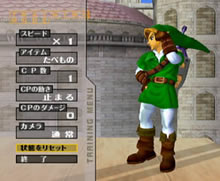
The Link on the left actually has this blobby, yellow body for a hitbox.
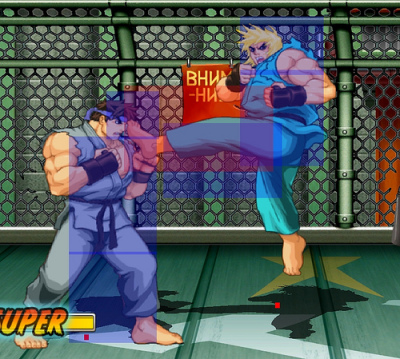
A hitbox is the 2D image or 3D model that is calculated by a computer system to determine if an object will collide, hit, stop, or interact with another game object. One wide spread example of 3D hit boxes at work in video game systems is realistic physics. All games with 3D graphics and 3D gameplay has some kind of physics system in place. As long as there's gravity and/or objects can't pass through each other, there are physics at work.
When Link swings his sword out to hit an enemy, the exact position of the sword is being calculated at every step of the animation to see if the sword hits any part of the enemy's body. Some game developers fail to draw hitboxes tightly around their visual sprites/models. Failing to do so can create frustrating moments where it looks like you did one thing and the game tells you you did another. In other words, it may look like you dodged an attack, yet the game insists that you've been hit. It may look like you landed on the platform, but the game makes you fall to your doom. Though many games from Super Mario Brothers to Halo tweak their hitboxes for playability, ensuring that the forms (visuals) closely match the function (hitbox interactions) is key. The more accurately a 3D video game draws its hitboxes the tighter the game will be.
Some examples of video games with great 3D hitboxes and object interaction are...
- Katamari Damacy
- Wii Sports: Boxing
- Boom Blox
- Shadow of the Colossus
- Forza Motorsports
In part 4, I'll cover 3D inputs and the specific styles of 3D gameplay.





Reader Comments (4)
I love that games are getting more and more advanced. I'm a big fan of Starcraft 2 that you mentioned, and I think it looks and plays 100 times better than the original thanks to these advancements.
Gaming to day keeps getting better i remember when tomb raider came out and i was thinking that was good graphics.
This is really informative
In my experience, the graphics and the 2D/3D nature of the graphics is always secondary to the gameplay.. Some 2D games blow away some 3D games.. For example, StarCraft 2 may not be the best 3D game ever made, however, the gameplay is what matters.. and it's strong.